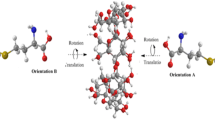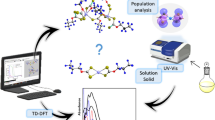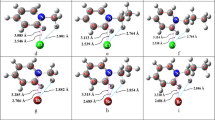Abstract
The conformational isomerism, relative stabilities of isomeric forms, acid–base behavior, and hydrogen bonding of formylphosphinous acid (FPA), an isostere of formohydroxamic acid (FHA) and its tautomer formylphosphine oxide have been analyzed in the present study. Molecular orbital and density functional theory methods in conjunction with 6-31+G* basis set have been employed. The protonation, deprotonation, and hydrogen bonding abilities of FHA and FPA have been compared. FPA has P as preferred site of deprotonation like N in FHA, but they differ in their preferred site of protonation. With similar nature and orientation of H-bond donor and acceptor atoms, stabilization energy of most stable aggregate of FHA with water is 0.99 kcal/mol higher than that of similar aggregate of FPA with water. In addition, FPA is more stable than its corresponding oxide form in gas phase as well as on H-bonding interaction with single water molecule.







Similar content being viewed by others
References
Bridger WA, Henderson JF (1983) Cell adenosine triphosphate physiology. Wiley, New York
Lehninger AL, Nelson DL, Cox MM (1993) Principles of biochemistry. Worth Publishers, New York
Babin YV, Prisyazhnyuk AV, Ustynyuk YA (2008) Russ J Phys Chem B 2:684
Hoge B, Garcia P, Willner H, Oberhammer H (2006) Chem Eur J 12:3567
Corbridge DEC (1995) Phosphorus: an outline of its chemistry, biochemistry and uses, 5th edn. Elsevier, Amsterdam
Chatt J, Heaton BT (1968) J Chem Soc A 2745
Griffiths JE, Burg AB (1960) J Am Chem Soc 82:1507
Virlichie JL, Dagnac P (1977) Rev Chim Miner 14:355
Dobbie RC, Straughan BP (1971) Spectrochim Acta 27:255
Dubrovina NV, Borner A (2004) Angew Chem 116:6007
Heydorn LN, Burgers PC, Ruttink PJA, Terlouw JK (2003) Int J Mass Spectrom 228:759
Wesolowski SS, Brinkmann NR, Valeev EF, Schaefer HF III, Repasky MP, Jorgensen WL (2002) J Chem Phys 116:112
Hoge B, Thösen C, Herrmann T, Panne P, Patenburg I (2004) J Fluorine Chem 125:831
Hoge B, Wiebe W, Hettl S, Neufeind S, Thösen C (2005) J Organomet Chem 690:2382
Frisch MJ, Trucks GW, Schlegel HB, Scuseria GE, Robb MA, Cheeseman JR, Zakrzewski VG, Montgomery JA, Stratmann RE, Burant JC, Dapprich S, Millam JM, Daniels AD, Kudin KN, Strain MC, Farkas O, Tomasi J, Barone V, Cossi M, Cammi R, Mennucci B, Pomelli C, Adamo C, Clifford S, Ochterski J, Petersson GA, Ayala PY, Cui Q, Morokuma K, Rega N, Salvador P, Dannenberg JJ, Malick DK, Rabuck AD, Raghavachari K, Foresman JB, Cioslowski J, Ortiz JV, Baboul AG, Stefanov BB, Liu G, Liashenko A, Piskorz P, Komaromi I, Gomperts R, Martin RL, Fox DJ, Keith T, Al-Laham MA, Peng CY, Nanayakkara A, Challacombe M, Gill PMW, Johnson B, Chen W, Wong MW, Andres JL, Gonzalez C, Head-Gordon M, Replogle ES and Pople JA (2001) In: Gaussian98. Gaussian, Inc., Pittsburgh, PA
Becke AD (1993) J Chem Phys 98:5648
Lee C, Yang W, Parr RG (1988) Phys Rev B 37:785
Foster JP, Weinhold F (1980) J Am Chem Soc 102:7211
Reed AE, Weinhold F, Curtiss LA (1988) Chem Rev 88:899
Reed AE, Schleyer PVR (1990) J Am Chem Soc 112:1434
Bharatam PV, Iqbal P, Malde A, Tiwari R (2004) J Phys Chem A 108:10509
Remko M, Liedl KR, Rode BM (1996) J Chem Soc Perkin Trans 2:1743
Boys SF, Bernardi F (1970) Mol Phys 19:553
Kaur D, Kohli R (2008) Int J Quantum Chem 108:119
Kaur D, Kohli R, Kaur RP (2008) J Mol Str (Theochem) 864:72
Wu DH, Ho JJ (1998) J Phys Chem A 102:3582
Kakkar R, Grover R, Chadha P (2003) Org Biomol Chem 1:2200
Author information
Authors and Affiliations
Corresponding author
Electronic supplementary material
Below is the link to the electronic supplementary material.
Rights and permissions
About this article
Cite this article
Kaur, D., Kohli, R. Hydrogen bonding ability and acid–base behavior of formylphosphinous acid: an isostere of formohydroxamic acid. Struct Chem 23, 1879–1890 (2012). https://doi.org/10.1007/s11224-012-9998-x
Received:
Accepted:
Published:
Issue Date:
DOI: https://doi.org/10.1007/s11224-012-9998-x




